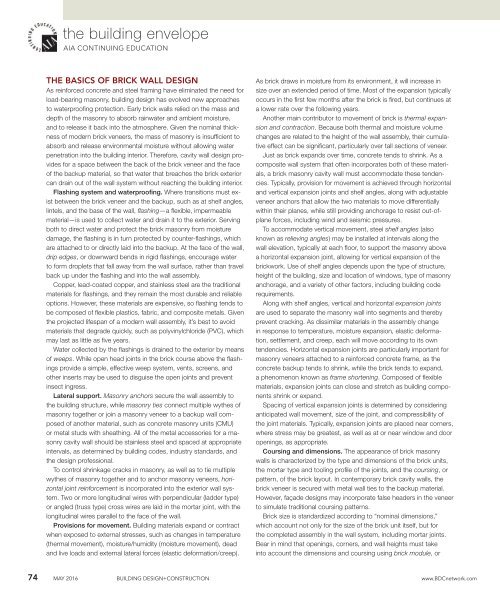Building Design Construction
Create successful ePaper yourself
Turn your PDF publications into a flip-book with our unique Google optimized e-Paper software.
the building envelope<br />
AIA CONTINUING EDUCATION<br />
THE BASICS OF BRICK WALL DESIGN<br />
As reinforced concrete and steel framing have eliminated the need for<br />
load-bearing masonry, building design has evolved new approaches<br />
to waterproofi ng protection. Early brick walls relied on the mass and<br />
depth of the masonry to absorb rainwater and ambient moisture,<br />
and to release it back into the atmosphere. Given the nominal thickness<br />
of modern brick veneers, the mass of masonry is insuffi cient to<br />
absorb and release environmental moisture without allowing water<br />
penetration into the building interior. Therefore, cavity wall design provides<br />
for a space between the back of the brick veneer and the face<br />
of the backup material, so that water that breaches the brick exterior<br />
can drain out of the wall system without reaching the building interior.<br />
Flashing system and waterproofing. Where transitions must exist<br />
between the brick veneer and the backup, such as at shelf angles,<br />
lintels, and the base of the wall, fl ashing—a fl exible, impermeable<br />
material—is used to collect water and drain it to the exterior. Serving<br />
both to direct water and protect the brick masonry from moisture<br />
damage, the fl ashing is in turn protected by counter-fl ashings, which<br />
are attached to or directly laid into the backup. At the face of the wall,<br />
drip edges, or downward bends in rigid fl ashings, encourage water<br />
to form droplets that fall away from the wall surface, rather than travel<br />
back up under the fl ashing and into the wall assembly.<br />
Copper, lead-coated copper, and stainless steel are the traditional<br />
materials for fl ashings, and they remain the most durable and reliable<br />
options. However, these materials are expensive, so fl ashing tends to<br />
be composed of fl exible plastics, fabric, and composite metals. Given<br />
the projected lifespan of a modern wall assembly, it’s best to avoid<br />
materials that degrade quickly, such as polyvinylchloride (PVC), which<br />
may last as little as fi ve years.<br />
Water collected by the fl ashings is drained to the exterior by means<br />
of weeps. While open head joints in the brick course above the fl ashings<br />
provide a simple, effective weep system, vents, screens, and<br />
other inserts may be used to disguise the open joints and prevent<br />
insect ingress.<br />
Lateral support. Masonry anchors secure the wall assembly to<br />
the building structure, while masonry ties connect multiple wythes of<br />
masonry together or join a masonry veneer to a backup wall composed<br />
of another material, such as concrete masonry units (CMU)<br />
or metal studs with sheathing. All of the metal accessories for a masonry<br />
cavity wall should be stainless steel and spaced at appropriate<br />
intervals, as determined by building codes, industry standards, and<br />
the design professional.<br />
To control shrinkage cracks in masonry, as well as to tie multiple<br />
wythes of masonry together and to anchor masonry veneers, horizontal<br />
joint reinforcement is incorporated into the exterior wall system.<br />
Two or more longitudinal wires with perpendicular (ladder type)<br />
or angled (truss type) cross wires are laid in the mortar joint, with the<br />
longitudinal wires parallel to the face of the wall.<br />
Provisions for movement. <strong>Building</strong> materials expand or contract<br />
when exposed to external stresses, such as changes in temperature<br />
(thermal movement), moisture/humidity (moisture movement), dead<br />
and live loads and external lateral forces (elastic deformation/creep).<br />
As brick draws in moisture from its environment, it will increase in<br />
size over an extended period of time. Most of the expansion typically<br />
occurs in the fi rst few months after the brick is fi red, but continues at<br />
a lower rate over the following years.<br />
Another main contributor to movement of brick is thermal expansion<br />
and contraction. Because both thermal and moisture volume<br />
changes are related to the height of the wall assembly, their cumulative<br />
effect can be signifi cant, particularly over tall sections of veneer.<br />
Just as brick expands over time, concrete tends to shrink. As a<br />
composite wall system that often incorporates both of these materials,<br />
a brick masonry cavity wall must accommodate these tendencies.<br />
Typically, provision for movement is achieved through horizontal<br />
and vertical expansion joints and shelf angles, along with adjustable<br />
veneer anchors that allow the two materials to move differentially<br />
within their planes, while still providing anchorage to resist out-ofplane<br />
forces, including wind and seismic pressures.<br />
To accommodate vertical movement, steel shelf angles (also<br />
known as relieving angles) may be installed at intervals along the<br />
wall elevation, typically at each fl oor, to support the masonry above<br />
a horizontal expansion joint, allowing for vertical expansion of the<br />
brickwork. Use of shelf angles depends upon the type of structure,<br />
height of the building, size and location of windows, type of masonry<br />
anchorage, and a variety of other factors, including building code<br />
requirements.<br />
Along with shelf angles, vertical and horizontal expansion joints<br />
are used to separate the masonry wall into segments and thereby<br />
prevent cracking. As dissimilar materials in the assembly change<br />
in response to temperature, moisture expansion, elastic deformation,<br />
settlement, and creep, each will move according to its own<br />
tendencies. Horizontal expansion joints are particularly important for<br />
masonry veneers attached to a reinforced concrete frame, as the<br />
concrete backup tends to shrink, while the brick tends to expand,<br />
a phenomenon known as frame shortening. Composed of fl exible<br />
materials, expansion joints can close and stretch as building components<br />
shrink or expand.<br />
Spacing of vertical expansion joints is determined by considering<br />
anticipated wall movement, size of the joint, and compressibility of<br />
the joint materials. Typically, expansion joints are placed near corners,<br />
where stress may be greatest, as well as at or near window and door<br />
openings, as appropriate.<br />
Coursing and dimensions. The appearance of brick masonry<br />
walls is characterized by the type and dimensions of the brick units,<br />
the mortar type and tooling profi le of the joints, and the coursing, or<br />
pattern, of the brick layout. In contemporary brick cavity walls, the<br />
brick veneer is secured with metal wall ties to the backup material.<br />
However, façade designs may incorporate false headers in the veneer<br />
to simulate traditional coursing patterns.<br />
Brick size is standardized according to “nominal dimensions,”<br />
which account not only for the size of the brick unit itself, but for<br />
the completed assembly in the wall system, including mortar joints.<br />
Bear in mind that openings, corners, and wall heights must take<br />
into account the dimensions and coursing using brick module, or<br />
74 MAY 2016 BUILDING DESIGN+CONSTRUCTION www.BDCnetwork.com






